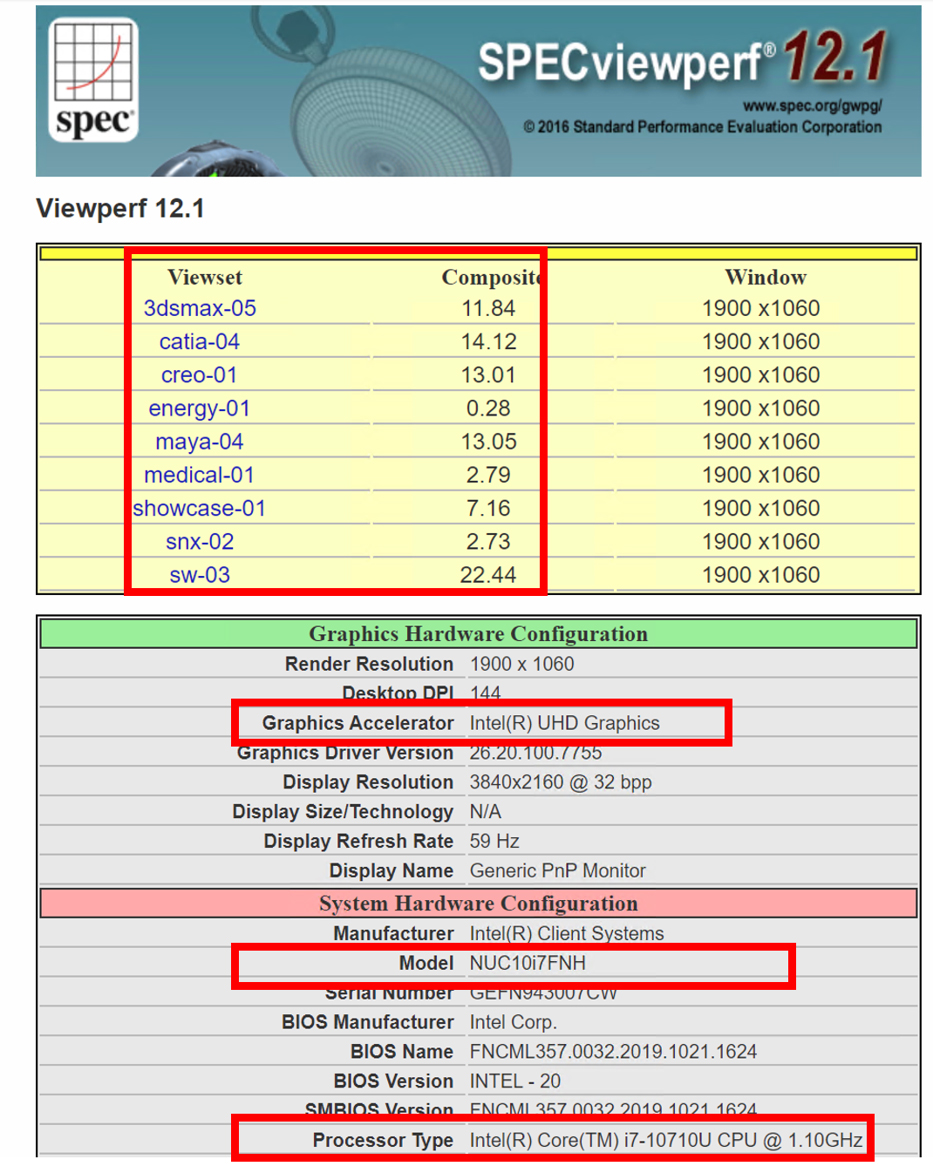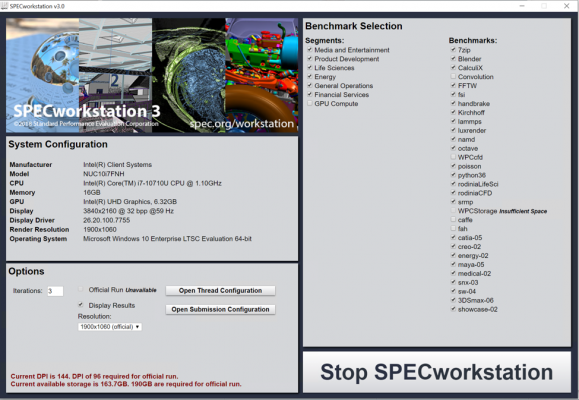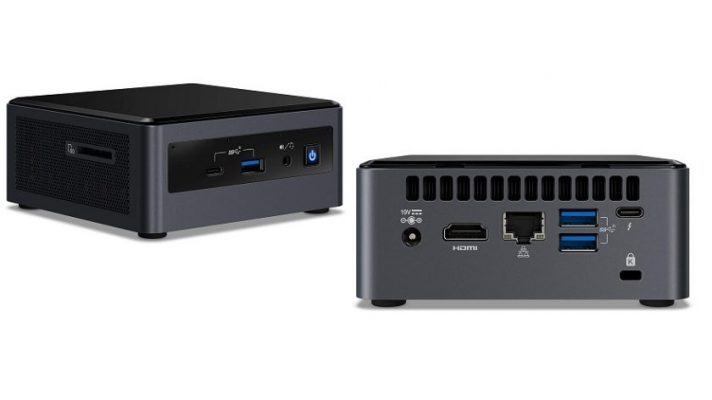Should you buy Intel NUC 10 Performance mini PC now? Intel has another Comet Lake NUC called the NUC10i7FNK. Whereas the NUC10i7FNH has 2” tall case and a 2.5” SATA drive slot the NUC10i7FNK case is slightly shorter at 1.5” and does not have a SATA drive slot. The mainboard and the CPU are the same in both of these systems. Find more in our ntel NUC 10 Performance mini PC review.
Intel NUC systems are used by enthusiast that want to build a home lab that take up a minimal amount of space, custom builders that configure them for a specific purpose such edge computing or to build up powerful entertainment systems, and others that are looking for a quiet, system that take up a minimal amount of space. But should you buy Intel NUC 10 Performance mini PC now?

[ebayfeedsforwordpress feed=’http://rest.ebay.com/epn/v1/find/item.rss?keyword=Intel+NUC+10+Performance+mini+PC+&sortOrder=BestMatch&programid=1&campaignid=5338674945&toolid=10039&customid=Intel+NUC&listingType1=All&descriptionSearch=true&feedType=rss&lgeo=1′ items=’5′]
Intel NUC 10 Performance mini PC specs
Why you will buy Intel NUC 10? There are many reasons to consider to buy new Intel NUC. Find below the specs.
General
- Brand : Intel
- Series : NUC (Next Unit of Computing)
- Model : BXNUC10I7FNH1
- Form Factor : UCFF (4″ x 4″)
CPU Supported
- CPU Type : Intel Core i7-10710U
- Processor (12M Cache, up to 4.7 GHz)
Memory Supported
- Memory slot : 2 x 260Pin SO-DIMM
- Memory Type Supported : DDR4 2666
- Max Memory Supported : 64GB
- Dual Channel Memory Supported : Yes
Storage
- Hard Drive Installed : No Hard Drive
- Serial ATA2 x SATA 6.0Gb/s
- M.2 : 22×42/80
Graphics
- Onboard Video : Intel UHD Graphics (One of the good reason to buy Intel NUC)
Audio
- Channel : 7.1 Channel
Communications
- LAN : Intel i219V
- Max LAN Speed10/100/1000Mbps
- Wireless LAN : Intel Wireless-AX MAC
- Bluetooth : Yes
Extension Bays
- 2.5″ Internal Bays : 1
Front Panel Ports
- Front USB : 2 x front USB 3.1 Gen2 (Type-A, Type-C)
- Front Audio Ports : 1 jack
- Card Reader : SDXC with UHS-II support (Side)
Back Panel Ports
- HDMI : HDMI 2.0a
- Thunderbolt 3 : 1
- Rear : USB2 x rear USB 3.1 Gen2 (Type-A)
- RJ45 : 1
Power Supply
- Power Supply : 19 VDC
Features
- Create or consume limitless content with the power of Intel NUC 10 Performance kits.
- Small enough to fit in the palm of your hand, they feature the performance of 10th generation Intel Core processors, Intel UHD graphics, and are ready to be customized with your choice of OS, memory, and storage drive (a solid reason to buy Intel NUC).
- Intel NUC: The performance you need in the space you have.
Intel NUC 10 Performance mini PC comparison
| Processors | Connectivity | Audio |
|---|---|---|
| NUC10i7FN Intel® Core™ i7-10710U processor (1.1 GHz – 4.7 GHz Turbo, 6 core, 12 thread, 12 MB Cache, 25W) NUC10i5FN Intel® Core™ i5-10210U processor (1.6 GHz – 4.2 GHz Turbo, 4 core, 8 thread, 6 MB Cache, 25W) NUC10i3FN Intel® Core™ i3-10110U processor (2.1 GHz – 4.1 GHz Turbo, 2 core, 4 thread, 4 MB Cache, 25W) Storage Capabilities NUC10i7FNK, NUC10i5FNK, & NUC10i3FNK M.2 22×42/80 key M slot for PCIe* x4 Gen3 NVMe*/AHCI or SATA3 SSD Full-size SDXC UHS-II slot NUC10i7FNH, NUC10i5FNH, & NUC10i3FNH M.2 22×42/80 key M slot for PCIe* x4 Gen3 NVMe*/AHCI or SATA3 SSD SATA3 SSD, 2.5″ 7mm SATA3 bay and port Full-size SDXC UHS-II slot System Memory Two DDR4 SODIMM sockets (Dual channel DDR4-2666 SODIMMs, 1.2V, 64 GB max) | HDMI* 2.0a port Thunderbolt™ 3 port Intel WiFi 6 AX200 2×2 Bluetooth® v5 Front: USB 3.1 Gen2 Type-C port with 5V/9V fast phone charging profile Front: USB 3.1 Gen2 Type-A port Back: Two USB 3.1 Gen2 ports Intel® Ethernet Connection I219-V 10/100/1000 Mbps System BIOS 256 Mb Flash EEPROM with Intel® Platform Innovation Framework for EFI plug and play Advanced configuration and power interface V5.0b, SMBIOS2.5 Intel BIOS Intel® Express BIOS Update support Hardware Management Features Voltage and temperature sensing ACPI-compliant power management control Expansion Capabilities 2x internal USB 2.0 headers | Up to 7.1 multichannel digital audio via HDMI* or Thunderbolt™ 33.5 mm stereo headset jack Beam-forming, far-field, quad-mic array Chassis Size Tall “H” Chassis 4.60″ x 4.40″ x 2.00″ 117 mm x 112 mm x 51 mm Slim “K” Chassis 4.60” x 4.40” x 1.50” 117 mm x 112 mm x 38 mm Power Requirements 19VDC 120W (NUC10i7FN models only), or 90W power supply, with geo-specific AC cords Environment Operating Temperature 0° C to +35 C Storage Temperature -20° C to +40° C Safety Regulations and Standards IEC/EN/UL 60950-1 IEC/EN/UL 62368-1 |
Intel NUC 10 Performance mini PC review
Design
The NUC10i7FNH is Intel’s mainstream HDD-kit NUC with a 100mm x 100mm main-board housed in a 117 x 112 x 51mm chassis. The board comes with a soldered processor – the Core i7-10710U. This belongs to the Comet Lake-U family, and is the first U-series processor with 6 cores and hyper-threading enabled. Thanks to Intel’s use of cTDP-up, the TDP of the processor is nominally at 25W, though the default BIOS settings set the PL1 (sustained) and PL2 (burst mode) levels to 30W and 64W respectively. Meanwhile the PL1 Time Window is set to 28 seconds by default.

Hardware
NUC, model NUC10i7FNH, is a fully-configured PC, not a kit, so it’s already outfitted with RAM—16 GB of it, which is ideal, though it can be upgraded to 64 GB—and storage—a 256 GB M.2-based NVMe SSD stick and a 7mm 1 TB SATA3 hard drive—in addition to its newer components and a slightly revised port selection. Those components include a 10th-generation “Frost Canyon” Core i7-10710U processor and Intel UHD Graphics that Intel says combine to create a mini-PC that is up to twice as fast as its predecessors.
Ports and connectors
The NUC 10 features the same ports and layout as its predecessor: There is a full-sized HDMI 2.0 port for video-out, a gigabit Ethernet port, two full-sized USB 3.1 Gen 2 ports, and a Thunderbolt 3/USB-C port. This is all good to buy this Intel NUC, for the most part, but I could really use one more full-sized USB port.
Initial Boot
For the initial boot and testing of the device, we connected the device to a Dell UltraSharp 32” 4K Monitor (U3219Q) via HDMI. The Dell monitor has a keyboard, mouse, and video (KVM) switch built into it. The monitors built-in KVM switch was extremely useful during our testing as it allowed us to switch between the NUC10i7FNH and our laptop with the push of a button. was used throughout our testing. We plugged a Dell wireless keyboard and mouse (part number KM636) keyboard/mouse’s dongle into the monitors upstream USB port. This is a good reason to buy Intel NUC.
We booted up the system and were presented with the Windows 10 Home (1903 build 18362.295) installation wizard. It took less than 5 minutes to install Windows and have the system running.
Configuration for Testing
Ideally, we would have liked to install Windows Server 2016 on this system unfortunately, Intel only provides drivers for Windows 10; Windows Server is not a supported OS on this NUC. When we tried to install Windows Server 2016 on this system, we were able to boot the Windows 2016 install media from a USB drive but got a “Loading Files” prompt twice and then a blank screen. Other have been able to install various versions of Windows servers on NUCs but had to build their own driver pack.
Rather than struggle with an unsupported OS on this system, we installed Window 10 Enterprise on the system, updated Windows and the BIOS to latest version, and installed all the suggested drivers on it.
Intel NUC 10 Performance mini PC Performance review
To evaluate the performance of the device we ran SPECworkstation 3 benchmarking test on it and compared the results to a NUC8i7BEHthat we recently tested.
SPECviewperf 12.1
SPECviewperf 12 benchmark, which is the worldwide standard for measuring graphics performance based on professional applications was run on the NUC10i7FNH. The SPECviewperf test runs 9 benchmarks called “viewsets,” which represent graphics content and behavior from actual applications and include categories such as 3D Max, CATIA, Creo, Energy, Maya, Medical, Showcase, Siemens NX, and Solidworks.

The NUC10i7FNH SPECviewperf was less performant than NUC8i7BEH which has a more powerful GPU. When viewing the SPECviewperf test on the NUC10i7FNH the output looked fine and our ad-hoc testing proved that the NUC10i7FNH is very usable in normal day-to-day usage, however for heavy graphics such as video editing or CAD work the NUC8i7BEH would be a better choice.
| Viewsets | NUC8i7BEH | NUC10i7FNH |
| 3dsmax-06 | 20.74 | 11.84 |
| catia-05 | 21.33 | 14.12 |
| creo-02 | 17.57 | 13.01 |
| energy-02 | 0.39 | 0.28 |
| maya-05 | 24.55 | 13.05 |
| medical-02 | 5.32 | 2.79 |
| showcase-02 | 12.68 | 7.16 |
| snx-03 | 2.96 | 2.75 |
| sw-04 | 35.13 | 22.44 |
SPECworkstation 3
SPECworkstation 3 is a specialized test designed for benchmarking the key aspects of workstation performance; it uses over 30 workloads to test CPU, graphics, I/O, and memory bandwidth. The workloads fall into seven broad categories; Media and Entertainment, Product Development, Life Sciences, Energy, Financial Services, General Operations, and GPU Compute. We are going to list the broad-category results for each, as opposed to the individual workloads. The results are an average of all the individual workloads in each category.

The results (Table1) show that the NUC10i7FNH system with its Intel i7-10710U hexa-core processor was more performant than the NUC8i7BEH system which had a quad-core i7-8559U CPU. We did have the SPECworkstation 3 GPU Compute category timeout due to an issue with the Caffe application on the NUC8i7BEH systems. Overall the results are inline, and what we would expect for a system with an Intel i7-10710U CPU that has 2 more cores which equates to 50% more cores and threads than the i7-8559U processer in the NUC8i7BEH.
| NUC8i7BEH | NUC10i7ZFNH | |
| M&E | 0.93 | 1.34 |
| ProdDev | 1.09 | 1.42 |
| LifeSci | 0.78 | 1.40 |
| Energy | 0.70 | 0.70 |
| Financial Services | 1.04 | 1.40 |
| General Operations | 1.38 | 1.38 |
| GPU Compute | Timed out | 0.46 |
PCMark 10
Earlier this year we reviewed a Lenovo ThinkCentre M90n Nano and Lenovo ThinkCentre M90n-1 Nano IoT (reviews located here and here). Below is a comparison of the Nano system to the NUC10i7FHN using PCMark 10. We tested the NUC10i7FNH using both the HHD and the SSD drive.
| PCMark 10 | |||
| ThinkCentre M90n-1 Nano IoT | ThinkCentre M90n Nano | NUC10i7FNH SSD / HDD | |
| Total Score | 3,033 | 3,825 | 4,268 /4,093 |
| Essentials | 7,140 | 8,684 | 8,472 /7,405 |
| Productivity | 5,756 | 6,217 | 6,837 /6,657 |
| Digital Content Creation | 1,843 | 2,813 | 3,643 /3,775 |
| Processor | 8 Gen i3-8145U 2 cores 4 threads Clock speed 2.2/3.9GHz Intel UHD Graphics 620 | 8 Gen i7-8665U 4 cores 8 threads Clock speed 1.9/4.8GHz Intel UHD Graphics 620 | 10 Gen i7-10710U 6 cores 12 threads Clock speed 1.1/4.7GHz Intel UHD Graphics 620 |
This was an interesting comparison as each of the systems had a different processor with a different number of cores but all of the systems had the same integrated GPU. As expected, the Intel NUC 10 NUC10i7FNH with its 6 cores had the highest total score, followed by the 4 core M90n Nano and then the 2 core M90n-1 Nano IoT. What was unexpected was that the Digital Content Creation score was slightly higher when we used the HDD on the NUC10i7FNH than when we used the SSD.
Ad-Hoc Testing
Benchmarks are useful to quantify the performance of a device, but to get a better feel for how the device would perform for a typical home user we conducted other, less quantifiably tests on the systems. The first of these ad-hoc test that we conducted was using the MS Office suite, the second was using a web browser, and the third was based on video viewing.
In our MS Office testing, we edited a 23-page document that had imbedded graphics, an 8 sheet Excel spreadsheet and a 50 slide PowerPoint slide deck. The performance of the MS Office applications was very good and we did not notice any delay when going from the start to the end of the PowerPoint slide deck or any slow down when we had multiple documents open.
To test how well a web browser performed on the device we opened 10 tabs in Chrome browser to various sites and then switched between them without any lag or issues.
To test the performance of a streaming video on the device we played a 1080p YouTube video on the system in quarter scale mode and then in full screen mode. In quarter scale mode and in full screen mode we didn’t notice any dropped frames. The audio played flawlessly through a headset plugged in to the device.

To test the performance of local video and audio we used the libde265 player to play a 640 x 360 30 fps video that was stored locally on the system in quarter scale mode and then in full screen mode. We didn’t notice any frame drops in either mode. We also played a 4K (4096 x 1720 @ 24 fps) video and found that it played with only a barely noticeable jitter. The audio played flawlessly through a headset plugged in to the device during all the tests.

NUC10i7FNH vs. NUC8i7BEH
Invariable Intel’s new NUC10i7FNH will be compared to the 8th generation NUC8i7BEH. Below is comparison of the key hardware components. As this chart shows, and our testing proves out the NUC10i7FNH with its 6 cores, higher max clock speed and support of 64 GB of DDR4 2666 RAM can handle simultaneous processes and heavily multi-threaded applications better than the NUC8i7BEH. It also has a more advanced WiFi chip. Its GPU is less powerful that the one in the NUC8i7BEH however if you are not doing GPU intensive applications, such as gaming, CAD, or video editing the GPU in the NUC10i7FHN should be fine.
| Feature | NUC8i7BEH | NUC10i7FNH |
| Processor | i7-8559U 4 cores and 8 threads Clock speed 2.7/4.5 GHz MAX TDP 28W | i7-10710U 6 cores and 12 threads Clock speed 1.1/4.7 GHz MAX TDP 15W |
| GPU | Iris Plus Graphics 655 48 Execution Units | Intel UHD Graphics 620 18 Execution Units |
| RAM | 2 x DDR4 2400 Support for 32 GB | 2 x DDR4 2666 Support for 64 GB |
| WiFi | Intel Wireless-AC 9560 Max speed 1.73 Gbps | Intel AX 201 Max speed 2.4 Gbps |
One oddity that we found on the NUC10i7FNH is that it’s LED on indicator is a lot dimmer than that one on the NUC8i7BEH. It was a minor thing but in bright light it did make it difficult to tell if it was on.
Should you buy Intel NUC 10 Performance mini PC now and how much is price?
Intel shipped the NUC with Windows 10 Home, but I’ll probably upgrade that to Windows 10 Pro at some point so I can take advantage of Hyper-V. A barebones NUC 10 with this processor will cost about $620 from various online retailers, but with the RAM and storage, it’s probably getting close to $1000. That said, I see some incredible configurations—64 GB of RAM in many cases, and/or much more SSD storage—for about the same price. But still there is a reason to buy Intel NUC for its performance.
